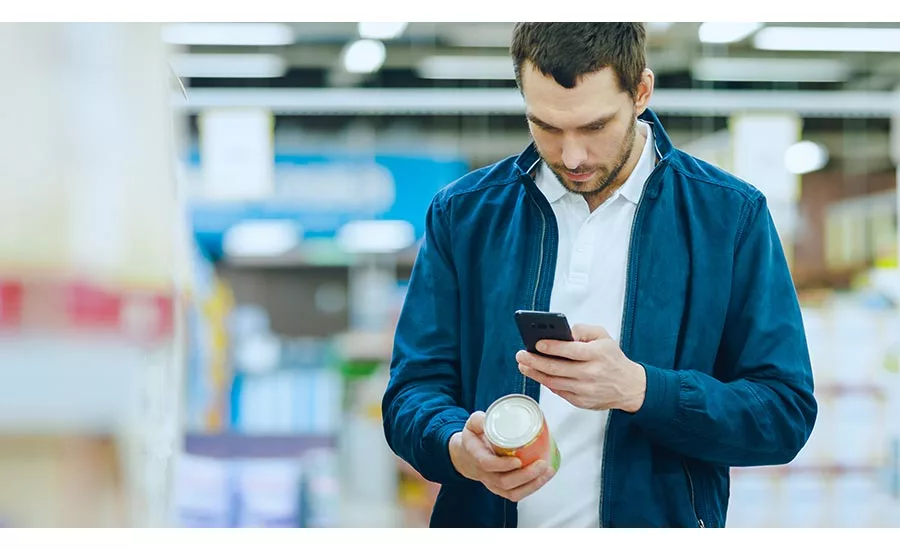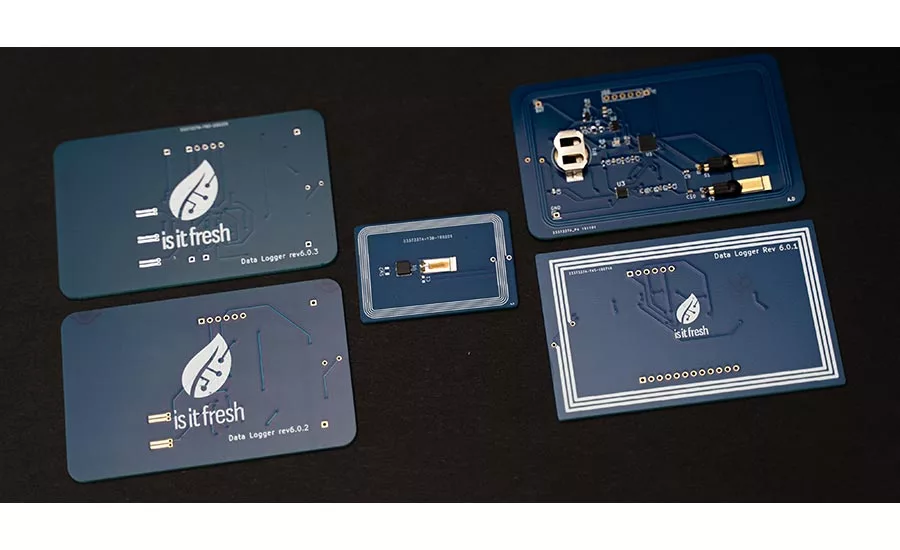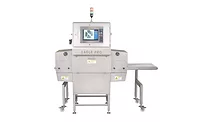Smart packaging: Connecting the physical with the digital
Technology embedded into packages makes a compelling business case for food processors, with the potential to reduce costs and increase profits.

Smartphones can be used to grab information from beverage and food packages, such as recipes, promotions and brand information.
Photo courtesy iStock/Getty Images Plus/gorodenkoff

Is It Fresh digitalizes packages at the individual level with ultra-low-cost RFID/NFC-enabled tracking and freshness sensors, integrated with a SaaS/private cloud data platform.
Photo courtesy Is It Fresh
In today’s food industry, a product’s package is every bit as important as its contents. Today’s packaging can be smart, embedded with technology that offers a range of functionality. According to research from Smithers Pira in “The Future of Active & Intelligent Packaging,” the smart packaging market is forecasted to grow at an annual average rate of 5.9%, reaching $7.56 billion by 2023.
Jan Schnitker, CEO and co-founder of Is It Fresh, a deep-tech startup that develops and produces supply chain digitalization technology, says that smart packaging is an umbrella term referring to packaging systems that have extended functionalities beyond only containing and protecting the package’s contents, using technology such as embedded sensors.

Jan Schnitker, CEO & co-founder, Is It Fresh

Thomas Dunn, independent consultant, EAS Consulting Group

Aric Prost, Sr. Director OEM, Stratus Technologies
“At Is It Fresh, we think of smart packaging as the enabler connecting physical assets with the digital platform,” he says.
There are two forms of smart packaging: active packaging and intelligent packaging. Active packaging involves adding or removing components into the packaged food or immediate surroundings to improve the product’s shelf life or quality, such as absorbers to remove oxygen from the package. Intelligent packaging refers to packaging that can do “intelligent” functions such as track the product, sense an attribute of the packaged food or its immediate environment (e.g., pH, temperature), and communicate it to the user (such as manufacturer or consumer).
As well, connected packaging is a subset of intelligent packaging, referring to applications that communicate with other packages, smart appliances or the internet to provide consumers unique content or value-added digital experiences.
Aric Prost, Sr., director of OEM, Stratus Technologies, sums up smart packaging as that which improves scheduling, tracking and achieving better utilization of equipment along with faster repair times.
For food processors, smart packaging can offer many benefits. According to Thomas Dunn, independent consultant at EAS Consulting Group, a firm that works in FDA- and USDA-regulated industries, smart packaging—particularly connected packaging—provides processors with powerful tools for complying with their product tracing and recall responsibilities in their food safety management programs.
“At present, printed symbols on packages decoded by optical (line of sight) sensors (e.g., bar and QR codes) are widely used,” he says. “Systems with omnidirectional decoding ability (e.g., RFID tags) are economical for transport packaging units, such as shipping cartons, but present cost and information management hurdles at the individual shelf item scale.” Current development efforts show promise in reaching the goal of producing RFID-type symbols on packages at the same minimal cost as today’s code-dating technology, Dunn adds.
Schnitker adds that smart packaging and automated supply chain management will significantly reduce costs and increase profits. “There are plenty of use-cases that are enabled through smart packaging, specifically if this smart packaging is introducing digitalization at the same time,” Schnitker says.
He says that typical benefits include:
- Traceability—the serialized package and its production meta-information that can be shared with value-chain participants and easily be read out via near-field communication (NFC)
- Ability to distinguish and provide transparent evidence of quality standards through a technology-layer
- In-situ production parameter control, reducing risks for out-of-specification production
- The reduction of lab costs for quality control
- Connecting the food processor with the end customer
- Handling of product recalls efficiently with a much lower potential for brand damage
He points out that food processors can enhance their reputation on societal/environmental responsibility by reducing food wastage through this technology.
“The food processor is probably one of the most important, if not the key enabler of its value chain to reduce the excessive waste in developed countries,” Schnitker says. “Food needs to be smart right from its manufacturing/packaging process to capture the immense potential and profits.
“According to a Boston Consulting Group report, $1.2 trillion worth of food is wasted or lost per year, hitting about $1.5 trillion by 2030. What is maybe even more interesting food processing and packaging has an average loss/waste of about $0.82 per kg that can partially be recuperated with smart packaging. Food processors that realize this win-win from scenario an economical and sustainability standpoint earlier than their competitors will have a huge competitive advantage,” he says.
Integration
Food processors can integrate this technology a number of ways. Schnitker says the first step is the physical integration, which happens in different ways depending on the packaging type, label technology and sensor technology used. A typical integration would be a pressure-sensitive adhesive that is applied to the inside or outside of the packaging, which does not differ in its complexity to industry-standard labels. So it can be as easy as exchanging the label type or adding a label.
Smart packaging that uses chemical sensors and evaluates freshness via a liquid or gas-sensing principle requires a “molecular pathway" to the sensor element. “This can happen through direct contact or through membrane materials in such a way that the analyte is able to reach the sensing element,” Schnitker says. “The entire sensor and label can also be embedded in the packaging stack in more advanced scenarios. Food processors would simply purchase a different packaging type from their packaging supplier.
The second step is digital integration during production. The smart food package would pass by, for example, on a conveyor belt through an NFC and optical readout tunnel that registers the smart label in real-time, associates all the product information, and generates the first measurement of the quality. “This process happens with a complete IT/OT-integration, full cloud-support, and automatic data analysis. Essentially any manufacturing line can be retrofitted with such a solution very cost effectively,” he says.
Dunn says some food processors are taking advantage of QR codes on packages and smart devices in consumers’ hands to leverage printed but space-limited label or package data with dynamic product information available on the Internet.
“Proposed FDA proposals regarding food traceability records for certain foods require that electronic sortable spreadsheets, containing relevant traceability information, be available to the agency within 24 hours its request. Package QR codes will support real time consumers access to lot identifiers of these foods during FDA recall investigations,” says Dunn.
Prost notes that embedding track/trace capabilities can take a number of forms. “[Stratus] enable[s] control or software to be operated on machine (addressing latency issues), on prem [on-premises infrastructure] and/or in the cloud. Our high availability and redundant options mean that concerns about losing this critical data are minimized,” he says.
Evolution
According to Dunn, the most practiced form of smart packaging involves time temperature indicators (TTIs), originally proposed in the early 1950s. These devices—usually for products with refrigerated or frozen storage and distribution—document thermal exposure and may estimate the remaining shelf life of perishable products, he says. Indicators take several forms: irreversible chemical color changes resulting from the accumulated effects of time and temperature on a distinctive image; enzyme-caused color changes proportional to cumulative time above an activation temperature; thermal expansion thermometers with ongoing data logging.
“TTI-functionality for packages provides more value for the supply chain upstream of consumer display where environmental monitoring data is available to verify on-package information and support save vs. discard decisions. Temperature dependence of the efficacy of some pharmaceuticals (not only their safety) gives more value to TTI technology for those products than does its use for packaged food point-of-use,” Dunn says.
Dunn notes that in spite of recent allegations about using code dating of packaged foods to prompt consumers to waste otherwise good food, smart packaging functionality is not a favored solution. “The commercial implications of letting consumers use package color changes to distinguish between products that are good and safe and those that are spoiled or unsafe are substantial: product liability for unsafe products labeled as ‘safe’ and the lost value of prematurely identified ‘out-of-date,’ unsalable products. These concerns dictate that the precision and accuracy of information be faultless. False negatives put spoiled or unsafe smart packaging product in consumer households while false positives risk substantial waste of good food,” says Dunn.
Schnitker adds, “Many of the available solutions in the market are also expressing ‘smartness,’ such as a freshness indicator on packages that changes color to indicate the chemical spoilage of food, which are very helpful in many ways but don't help a large amount of supply chain participants,” he says.
According to Dunn, TTI technology has evolved to more advanced biological (e.g., enzymatic) and physical (e.g., differential thermal expansion) techniques. “For valuable, temperature-sensitive food products, careful monitoring and data logging of ambient storage and transport temperatures provide cost and accuracy advantages over on-package TTI technology,” he says.
Additionally, he says that there is an array of smart packaging definitions among specific segments in the industry. “We believe that one distinctive element will be two criteria. First, there is the digitalization criteria. If we abstract the goals of packaging looking into the future, it would be reasonable to argue that it has evolved from being a mere ‘container’ of food product that is simply a barrier between the food product and the outside to a ‘communicator.’ Or, a connector that links the physical world and the digital world, as well as connecting the product to the consumer with different means like a sensor or display technology.
“We believe that there is another criterion that is going hand in hand with customer needs—it is becoming visible to the customer. Previous advances of smart packaging with better diffusion barriers, modified atmosphere packaging and many other very useful technologies are barely noticed by the end consumer. This relationship will change, in our opinion,” Schnitker says.
“Our particular angle at Is It Fresh is the ultra-cost-efficient transformation of the physical asset into a digital asset that fulfills both criteria mentioned above in the sense of a ‘connected product’ that utilizes advanced packaging materials and sensor technology to provide real-time info and analytics on dozens of parameters for full end-to-end tracking for every supply chain participant—so a B2B2C-compatible solution,” he says.
Challenges
Smart food packaging inherently involves the delivery of information about that food to a responsible party—a consumer, warehouse manager, delivery driver, etc. Dunn says that information is not an end in itself, but rather support for a decision by the receiving party. “Should the consumer buy that package or not? Should the warehouse manager discard product that experienced excessive heat? Should the driver check the thermostat in his truck? Unless and until smart packaging can deliver timely, accurate and dependable information to support decision-makers at specific points in the food supply chain, it remains no more than an interesting tool for which no useful function exists—a solution in search of a workable problem to resolve.”
Definitive code dating of packaged products presents an unsolved problem, Dunn says.
“[This is a] difficult challenge that remains unworkable for now, but no less important because of the difficulty. The science of product ‘shelf life’ estimation distinguishes many critical input variables for which accurate sensors and data are simply lacking… product condition prior to packaging, protection by its packaging, physical forces to be encountered during transport; temperature and humidity during storage and display; cellular chemistry; genetic varieties; to name but a few.” Consumer partiality toward freshness and locally sourced products indicate their preferences for packaged foods with “first-day” quality. Dunn says that until food science defines for each food (actually for each recipe and process) that quality’s biologic, chemical and physical dimensions and their tendencies to change over time, no package is “smart enough” to signal that a food’s shelf life has expired.
Schnitker says that Is It Fresh is tackling these challenges. “First, we determine the label type and the integration, for example, by providing a roll of tags that is compatible with existing label dispensing systems or planning the necessary changes. This step depends heavily on the packaging type and can vary from very simple to complicated.” He says that advanced packaging integration questions are best answered with the supplier of the packaging material. “The biggest challenge for the easiest smart labels is less of a technical nature and more from a management and innovation perspective.”
He says the second challenge is the readout technology on the manufacturing floor, which must be integrated without any significant downtime into an existing line. “This is usually a very long and tedious process with a variety of partners from the electrical IT/OT side to the data management, ERP integration, etc. Often enough, this would not be feasible as a retrofit solution without shutting down lines for a long time,” Schnitker says.
“We are taking this entire issue out of the equation with our turnkey approach that is compatible with any existing system. We provide a drop-in solution that can always be used as an aftermarket installation. Typically, a tunnel is about 1 m in length that we put over a free segment into the line without modifying or touching existing installation, only requiring power and any form of internet connectivity via Ethernet, WiFi or 4G/5G.” He says the tunnel is completely self-sustained but has electrical connectivity to other systems if required.
In the Pipeline
Dunn says that in a high-tech, information-driven economy, the most valuable smart functionality from a package will be an ability to connect that package to the Internet of Things (IOT) that electronically stores and retrieves all food chain transactions involving the package together with the identity of parties responsible for those transactions. “Package code dating currently provides package-specific analog information that links to the food chain. Machine-readable (digital) code dating will likely provide the entry point for truly smart packages.”
When looking to the future, Schnitker says, “We believe that advanced sensor systems like ours will become in one way a standard. There will be large arrays of the sensor system and a very high degree of connectivity for efficient supply chains on the B2B side and equally a better end-consumer user experience (UX) with the ‘connected products.’ We also see a huge spike in direct-to-consumer food products like HMR/meal-kits. The pandemic has boosted this huge trend, and the integration of smart packaging is key for the logistics and delivery process.”
When looking to the future, Schnitker says, “We believe that advanced sensor systems like ours will become in one way a standard. There will be large arrays of the sensor system and a very high degree of connectivity for efficient supply chains on the B2B side and equally a better end-consumer user experience (UX) with the ‘connected products.’
“Nearly every risk metric rises with the trend to avoid well-established packaging technology, which ultimately leads to even more waste. The idea of saving a few grams of plastic, which can be recycled, stands in contrast to ecological CO2 footprint of nearly food product, which is orders of magnitude more valuable than plastic. Additionally, recycling of biodegradable materials is a challenge on its own,” Schnitker adds.
For more information, visit:
Is It Fresh, www.is-it-fresh.com
Stratus Technologies, www.stratus.com
EAS Consulting Group, www.easconsultinggroup.com
Looking for a reprint of this article?
From high-res PDFs to custom plaques, order your copy today!








